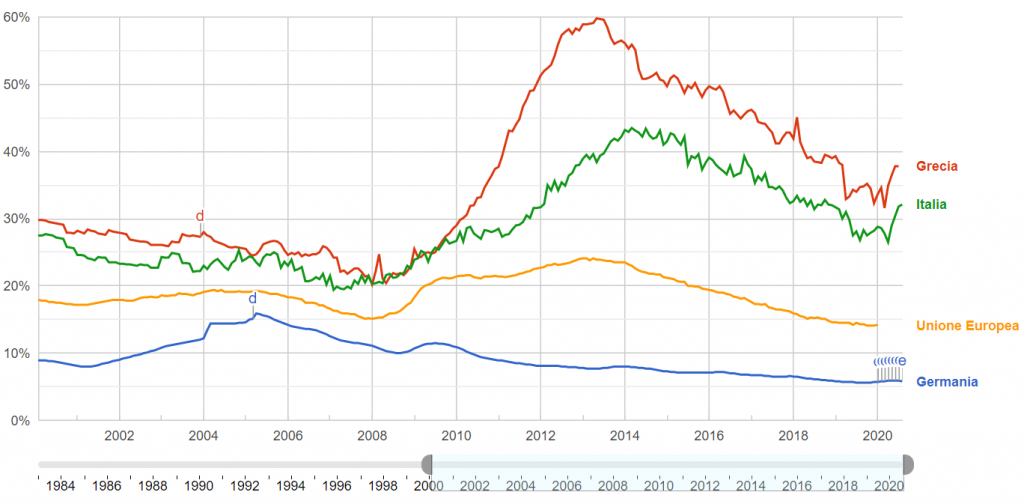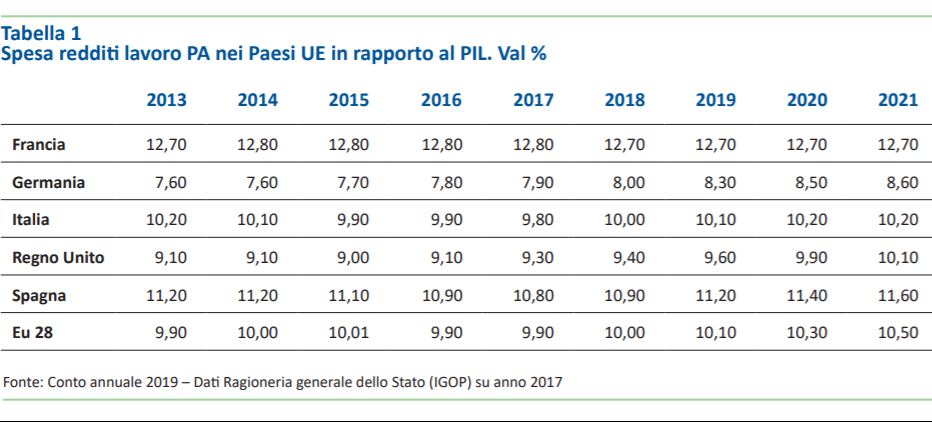Long before this pandemic, young Italians were considered the poorest and the most unemployed in Italy. In 2017, Business Insider Italia remarked the existence of a significant generational income gap between younger and older generations, as well as different equity in terms of real estate properties and wealth. According to this article, people under 30 owned less than 10% of the country’s net wealth, while people between 51 and 65 years old owned almost 30% of the country’s net wealth.
The graph below shows youth unemployment trends of under-25 individuals in the European Union from 2000 to October 2020. According to Eurostat, the average youth employment rate in EU countries in January 2020 was 14.2% respectively, while Germany (5.8% in August 2020) had already a lower percentage of young unemployed compared to the EU average.
On the other hand, Italy and Greece had historically very high unemployment rates among youths. Between 2012-2016 Italy reached peaks above 40% and in August 2020 around 32.1%, meanwhile, between 2012-2014 Greece (during its greatest crisis) reached the record figure of 59.8% in May 2013. Instead, in June 2020 Greek youth unemployment stood at 37.8%.

At first glance, these forecasts are not comforting
If we then consider how the pandemic is already affecting the global economy, the Italian national forecast can only get worse. Economic estimates for 2020 speak for themselves: Italy -11,2% of GDP, meanwhile the European Commission declared that it is very unlikely for Italy to return at pre-pandemic levels by 2022. In this situation, despite its good intentions, the Italian Government has not yet produced an efficient economic-strategic plan to raise the country’s morale and economy in the long-term.
As many economists and opposition politicians claim, the current economic crisis cannot be prevented with bonuses or one-off measures because the population is exhausted while anger is spreading throughout the peninsula. Additionally, the population accuses the government of giving delayed, scarce, and insufficient financial aids to counter the lockdowns.
To let non-Italian readers understand the seriousness of the situation, one might remember that many entrepreneurs have not yet received the state subsidies promised in March 2020. For this reason, the confidence of Italians in the current government heads is diminishing. Furthermore, the government’s financial measures have just skyrocketed the Italian National Debt exponentially, putting on the backs of young people an enormous responsibility, which is to relieve a country that before the pandemic had not yet fully recovered from the 2008 financial crisis.
Before proceeding further, let us take a step back to briefly explain Italian society.
A Brief Overview of the Italian Society
Italy has one of the oldest populations in EU and the birth rate is negative.
In 2019, Istat (National Institute for Statistics) published the yearly national demographic balance which showed that the birth rate was (-4,5%) meanwhile, there was an impressive rise in emigration rates (16,1%) compared to 2018.
Italy has one of the most inefficient and oldest Public Administration within the EU.
According to the General Accounting Office of the State and research by INAPP, Italy together with France and Spain has even the most expensive administration among its European neighbours.
Hence, to make things worse, this outlook does not seem to be decreasing soon because, as seen below, by 2021 the Public Administration GDP cost per year will still be 10,20. Therefore, the national government should reform the Public Administration by retiring a huge share of elderly public employees who find it difficult to embrace digitalization and start hiring young experts and graduates like Germany did.

On the job side, there are also huge entry barriers for young people.
As a matter of fact, a recent graduate is unlike to have 3-5 years of working experience, which is the minimum requirement nowadays. Arguably, an Italian employer should expect this kind of unpreparedness, but instead require ready-made and experienced employees. In this scenario, when entering the job market, the average wage is normally 400-1000 euros for apprenticeships.
Considering the living cost for rent, food and any other expenses, a salary like this is not enough to get over the month. Indeed during the first lockdown, a report of Sole24ore showed that under-35 with a 1000-euro average wage were the most affected by the crisis.
Due to this wage inequality, it is not surprising why many young Italians emigrate abroad to have better chances.
According to Andrea Carli (Sole24ore) and to the “ninth annual report on the economy of immigration” published in October 2019, in just 10 years, Italy has lost more than 250.000 young people (15-34 years old), resulting in a 16 billion financial loss (1% GDP).
Ageing population
Finally, Istat forecasts that by 2065, the Italian population will decrease to 55 million, and will be older. Undoubtedly, this is a dooming alarm which urges rapid, well-, and tailor-made policies to support the working class and give concrete solutions to the younger population.
Having briefly addressed these issues, let us come back to these days.
Basically, the main question is not what young people will do, rather what the Italian government(s) are going to do
Since March 2020, the Italian political debate has focused on preserving existing jobs rather than find future-oriented solutions. Reasonably, aiding small and medium-sized enterprises is the right choice since these entrepreneurs are the backbone of the Italian economy, but politics and politicians have lacked both vision and strategy on the long run. Consequently, during the COVID-19 pandemic there has never been any concrete political action nor debate towards “innovation”. Concretely, the Italian government is implementing the nationwide internet connection but there many endogenous factors that hinder other progress and innovative ideas. However, it would be unfair to only hold this government responsible for the socio-economic crisis.
Long story short, as elaborated above, it is fair to say that also decades of mismanagement, an old administrative, economic, and social system incapable of tackling global challenges led to this situation.
In the end, what shall a young Italian do?
In 2020, the best solution is still to emigrate, but where now?
Sources
Business Insider Italy (2017): Il divario economico tra vecchi e giovani si allarga sempre più. E i governi non riescono a fare niente, https://it.businessinsider.com/giovani-sempre-piu-poveri-vecchi-sempre-piu-ricchi-e-i-governi-non-fanno-niente-per-invertire-la-tendenza/, accessed 15.11.2020
Google Public Data (2020): Unemployment rate – Less than 25 years – Seasonally adjusted data, not calendar adjusted data, https://www.google.com/publicdata/explore?ds=z8o7pt6rd5uqa6, accessed 15.11.2020
Linkiesta (2020): Le stime sull’andamento dell’economia italiana della Commissione europea, https://www.linkiesta.it/2020/11/commissione-europea-italia-economia-pil-previsioni-covid-19/, accessed 15.11.2020
Sole24ore (2020): Italia senza futuro, l’Istat: minimo storico di nascite dall’Unità, https://www.ilsole24ore.com/art/italia-senza-futuro-l-istat-minimo-storico-nascite-dall-unita-ADM234d, accessed 15.11.2020
INAPP (2020): Uno sguardo sulla Pubblica amministrazione, INAPP_Giovannelli_Nugnes_Uno_sguardo_sulla_PA_Sinappsi_1_2020.pdf, accessed 15.11.2020
Sole24ore (2020): Under 35 e con stipendi sotto i mille euro, chi sono i lavoratori più colpiti dal semi lockdown, https://www.ilsole24ore.com/art/semi-lockdown-4-lavoratori-colpiti-10-sono-under-35-ADN9aLz, accessed 15.11.2020
Sole24ore (2020): In 10 anni l’Italia ha perso 250mila giovani: la fuga all’estero costa 16 miliardi, https://www.ilsole24ore.com/art/in-10-anni-l-italia-ha-perso-250mila-giovani-fuga-all-estero-costa-16-miliardi-AC0kqkp, accessed 15.11.2020
Sole24ore (2020): Istat: in Italia popolazione in calo di 6,5 milioni entro il 2065, sempre più anziani, https://www.ilsole24ore.com/art/istat-italia-popolazione-calo-65-milioni-entro-2065-sempre-piu-anziani-AEVGODiE, accessed 15.11.2020








Be First to Comment